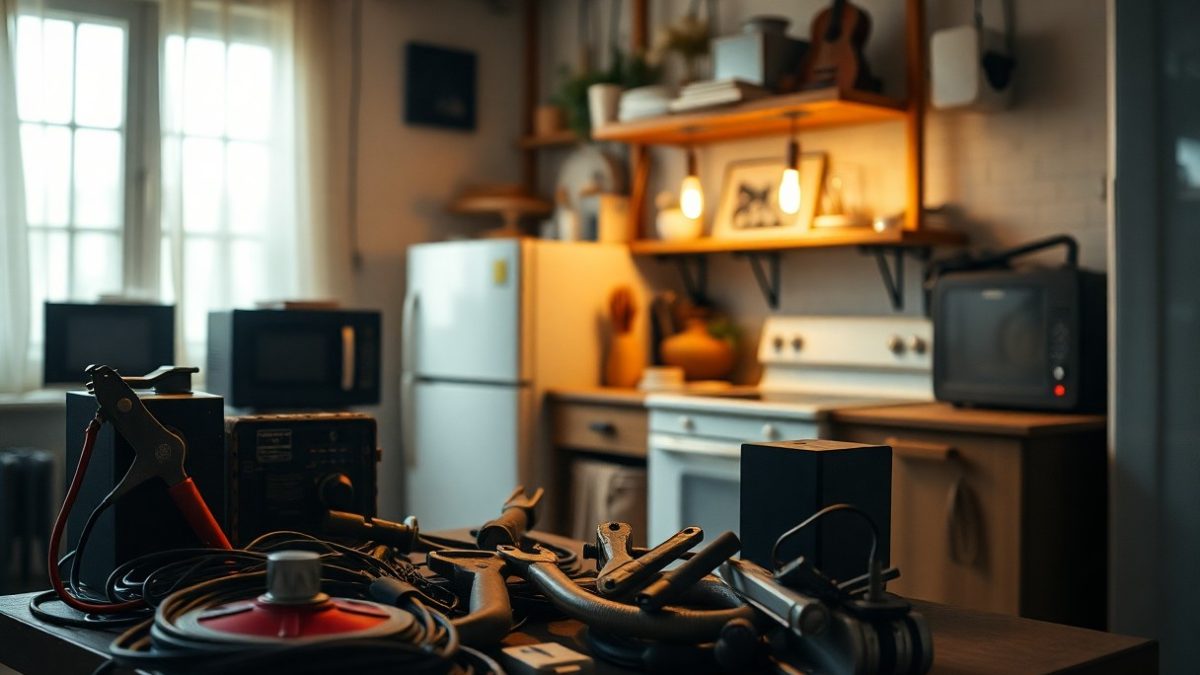
What Are The Quixotic Myths Surrounding Gas Vs. Electric Appliance Efficiency?
November 13, 2024
What Veritable Innovations Exist In Gas Installation Technology For Modern Homes?
November 15, 2024Just because electrical appliance installations today utilize advanced technology, it doesn’t mean outdated practices don’t linger in the background. You might be surprised to learn how these anachronistic methods can influence not only safety but also efficiency in your home. Recognizing these remnants from the past can help you make informed decisions when upgrading or installing new appliances. In this blog post, we will explore how these old practices continue to impact modern installations, and what you can do to ensure your home is both up-to-date and safe.
Historical Overview of Electrical Installations
Your understanding of electrical installations can be enriched by exploring their historical context. Initially, electrical systems were rudimentary and lacked standardized practices. Over the years, the rapid advancement in technology prompted the need for structured guidelines. As electrical installations became more widespread, understanding these historical nuances can help you appreciate the foundation upon which modern systems are built.
Evolution of Electrical Standards
Along this journey, electrical standards have evolved significantly, driven by safety and efficiency. Early electrical installations often operated without regulations, leading to hazardous situations. As knowledge grew, so did the introduction of codes and standards, ensuring better safety practices and consistency across installations. These evolving standards have paved the way for today’s reliable electrical systems.
Legacy Practices in Modern Installations
At the same time, certain legacy practices remain embedded in today’s electrical installations, affecting how you approach installations and repairs. These practices might seem outdated but often persist due to familiarity or ease of use.
Considering legacy practices in modern installations is vital as they can impact efficiency and safety. For example, use of older wiring methods or plugs can lead to compatibility issues with newer appliances. You may find that some electricians still rely on traditional techniques passed down through generations, which could be less effective than contemporary practices. Awareness of these legacy practices can help you make informed decisions during installations or upgrades, ensuring both safety and compliance with current standards.

Common Anachronistic Techniques
Clearly, an array of anachronistic practices in electrical installations persists today, often inherited from bygone eras. These outdated methods can create safety concerns and complicate modernization efforts. As discussed in “To Clarify an Everchanging Present” – Hyperchronicity, …, it’s necessary to bridge the gap between past practices and contemporary standards for a safer, more efficient future.
Use of Outdated Wiring Materials
An alarming number of electrical systems still utilize older wiring materials, such as knob and tube or aluminum wiring. These materials, while commonplace in the past, pose significant risks of overheating and fire hazards in today’s electrical context. Upgrading your wiring to modern standards ensures safety and compliance with current codes.
Preservation of Obsolete Safety Measures
Any installation may inadvertently adopt outdated safety measures that do not align with contemporary standards. This reliance on obsolete practices can undermine the overall effectiveness of your electrical system and create potential hazards.
Further, preserving these antiquated safety measures often leads to confusion during maintenance and repairs. The use of old circuit breakers, fuses, and grounding techniques may not adequately protect against current electrical loads. Updating to modern safety standards is key to enhancing your property’s electrical safety, preventing malfunctions, and reducing risks associated with electrical fires or electrocution.
Regulatory Challenges
Any analysis of anachronistic practices in electrical appliance installations reveals significant regulatory challenges. Many outdated methods and materials still exist due to a lack of modern guidance, leaving you navigating a complex web of compliance requirements. These inconsistencies often lead to confusion, inefficiencies, and potential hazards in today’s installations, making it necessary for you to stay updated on current regulations and standards.
Building Codes and Compliance Issues
Compliance with building codes is a fundamental aspect of ensuring safe and reliable electrical installations. You may find that outdated practices do not align with current code requirements, creating gaps that can jeopardize safety and legality. Staying informed and adapting your practices to meet modern standards not only enhances safety but also protects your investment in electrical systems.
Impact of Local Regulations on Practices
Practices in electrical installations can be heavily influenced by local regulations. These regulations often vary significantly from one jurisdiction to another, which can lead to inconsistencies in installation methods. Your understanding of local codes will not only help you avoid risks but also ensure that your installations comply with specific regional requirements, impacting everything from safety to insurance policies.
Codes governing electrical installations are tailored to address the unique challenges of various communities. Local regulations may arise from historical practices that have evolved over time, inadvertently perpetuating outdated methods. You should be aware that these local codes can either limit or enhance your installation options. By engaging with local authorities and understanding these regulations, you can ensure your practices align with both safety requirements and your local standards, ultimately leading to safer installations.
Risks Associated with Anachronistic Practices
To understand the risks of anachronistic practices, you must consider how outdated methods compromise your electrical appliance installations. Using obsolete techniques can lead to unsafe conditions, especially as modern appliances demand different installation standards. By relying on old practices, you expose your home to potential hazards that could jeopardize both safety and functionality.
Safety Hazards
Associated with anachronistic practices are significant safety hazards. When you use outdated materials or methods, you increase the risk of electrical fires, shocks, and equipment failures. Your installation may not meet current safety codes, exposing you and your loved ones to unnecessary danger.
Inefficiency and Increased Costs
Anachronistic approaches lead to inefficiency and increased costs in your electrical installations. As technology advances, old practices can hinder your ability to optimize energy consumption and performance in your appliances.
The reliance on outdated installation methods often results in higher energy bills and increased wear and tear on your electrical systems. When appliances are not installed following modern standards, the inefficiency can lead to frequent repairs, unexpected outages, and lower appliance lifespan. This ultimately means spending more resources on maintenance and operational costs over time, diminishing your long-term savings.
Modern Alternatives and Innovations
Many advancements in electrical technology have led to safer, more efficient installations. From smart appliances that communicate wirelessly to energy-saving devices that reduce power consumption, modern alternatives significantly enhance the functionality and effectiveness of your electrical systems. By leveraging these innovations, you can not only improve the performance of your appliances but also lower your environmental impact.
Advances in Electrical Technology
Before plunging into new installation practices, it’s important to understand how far electrical technology has evolved. Today’s systems offer improved safety features, such as circuit breakers that prevent overloads and smart technologies that enable remote monitoring. These advancements help you to create a more streamlined and responsive electrical environment, ensuring that your appliances operate efficiently.
Best Practices for Current Installations
To achieve optimal performance in your electrical installations, following best practices can make a significant difference. Prioritizing safety, using high-quality materials, and staying updated with local codes will enhance the durability and reliability of your electrical systems.
The adoption of best practices for current installations not only increases the lifespan of your appliances but also safeguards your home. By ensuring proper grounding, utilizing energy-efficient wiring methods, and embracing newer technologies like smart home systems, you can create a seamless connection between your electrical infrastructure and your lifestyle. This attention to detail helps you avoid common pitfalls and fosters a sustainable approach to energy consumption.
Case Studies
Now, let’s explore how anachronistic practices manifest in real-world installations through the following case studies:
- Case Study 1: 1970s homes with outdated wiring, resulting in a 30% higher energy consumption.
- Case Study 2: Frequent electrical malfunctions in buildings using 25-year-old circuit breakers, leading to 40% service interruption.
- Case Study 3: Compliance issues in commercial properties using legacy lighting systems causing a 50% increase in maintenance costs.
Examples of Anachronistic Installations in Use
Studies reveal that many older properties still operate with outdated electrical installations, including knob-and-tube wiring and aluminum circuits, which can present safety hazards while compromising energy efficiency.
Successful Modernizations
Behind many successful modernization efforts, you’ll find strategic upgrades that leverage contemporary electrical standards, significantly enhancing safety and efficiency in residential and commercial spaces.
Due to careful planning and implementation, these modernizations often replace outdated components with energy-efficient appliances and smart technology. For instance, transitioning from old incandescent bulbs to LED lighting can reduce energy costs by up to 75%. Additionally, upgrading wiring systems not only ensures compliance with current regulations but also provides greater reliability and performance, benefitting both you and your property in the long run.
Final Words
As a reminder, understanding how anachronistic practices influence today’s electrical appliance installations can significantly impact your safety and efficiency. You should be aware that outdated methods may compromise compliance with current standards and inhibit the effectiveness of modern appliances. By considering these historical practices in your installation processes, you can ensure your systems are not only functional but also aligned with today’s advancements in technology and safety regulations. Staying informed allows you to make better decisions for your home’s electrical needs.

